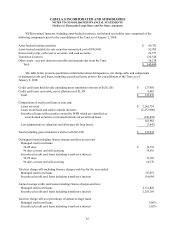Cabela's 2010 Annual Report Download - page 84
Download and view the complete annual report
Please find page 84 of the 2010 Cabela's annual report below. You can navigate through the pages in the report by either clicking on the pages listed below, or by using the keyword search tool below to find specific information within the annual report.74
CABELA’S INCORPORATED AND SUBSIDIARIES
NOTES TO CONSOLIDATED FINANCIAL STATEMENTS
(Dollars in Thousands Except Share and Per Share Amounts)
WFB retained rights to future cash flows from (i) finance charge collections, certain fee collections, allocated
interchange, and recoveries on charged-off accounts net of collection costs arising after investors have received the
return for which they are entitled; (ii) reimbursement for charged-off accounts; and (iii) after certain administrative
costs, such as servicing fees. This portion of the retained interests was known as interest-only strips and was
subordinate to investor’s interests. For interest-only strips and cash reserve accounts, WFB estimated related fair
values based on the present value of future expected cash flows using assumptions for credit losses, finance charge
yields, payment rates, and discount rates commensurate with the risks involved, but did not include interchange
income since interchange income was earned only when a charge was made to a customer’s account. The value of
the interest-only strips and cash reserve accounts were subject to credit, payment rate, and interest rate risks on the
loans sold. For cash accounts, WFB estimated related fair values based on the present value of future expected cash
flows using discount rates commensurate with the risks involved. Fair value changes in the interest-only strips and
cash reserve accounts were recorded in securitization income included in Financial Services revenue.
Inventories – Inventories are stated at the lower of average cost or market. All inventories are finished goods.
The reserve for inventory shrinkage, estimated based on cycle counts and physical inventories, was $5,775 and
$7,529 at the end of 2010 and 2009, respectively. The reserves for returns of damaged goods, obsolescence, and
slow-moving items, estimated based upon historical experience, inventory aging, and specific identification, were
$5,341 and $4,451 at the end of 2010 and 2009, respectively.
Vendor Allowances – Vendor allowances include price allowances, volume rebates, store opening costs
reimbursements, marketing participation, and advertising reimbursements received from vendors under vendor
contracts. Vendor merchandise allowances are recognized as a reduction of the costs of merchandise as sold.
Vendor reimbursements of costs are recorded as a reduction to expense in the period the related cost is incurred
based on actual costs incurred. Any cost reimbursements exceeding expenses incurred are recognized as a
reduction of the cost of merchandise sold. Volume allowances may be estimated based on historical purchases and
estimates of projected purchases.
Deferred Catalog Costs and Advertising – Advertising production costs are expensed as the advertising
occurs except for catalog costs which are amortized over the expected period of benefit estimated at three to
12 months after mailing. Unamortized catalog costs totaled $18,694 and $26,098 at the end of 2010 and 2009,
respectively. Advertising expense, including catalog costs amortization and website marketing paid search fees,
was $179,008, $188,312, and $212,379 for 2010, 2009, and 2008, respectively. Advertising vendor reimbursements
netted in advertising expense above totaled $1,501, $1,602, and $1,834 for 2010, 2009, and 2008, respectively.
Store Pre-opening Expenses – Non-capital costs associated with the opening of new stores are expensed as
incurred.
Leases – The Company leases certain retail locations, distribution centers, office space, equipment and land.
Assets held under capital lease are included in property and equipment. Operating lease rentals are expensed on
a straight-line basis over the life of the lease. At the inception of a lease, the Company determines the lease term
by assuming the exercise of those renewal options that are reasonably assured because of the significant economic
penalty that exists for not exercising those options. The exercise of lease renewal options is at the Company’s sole
discretion. The expected lease term is used to determine whether a lease is capital or operating and is used to
calculate straight-line rent expense. Additionally, the depreciable life of buildings and leasehold improvements is
limited by the expected lease term.
























